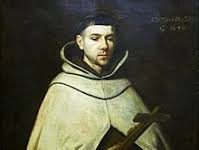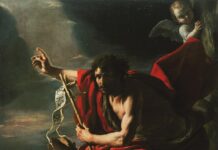“How can a soul as imperfect as mine aspire to the possession of the plenitude of Love? O Jesus, my first and only Friend, You whom I love UNIQUELY, explain this mystery to me! Why do You not reserve these great aspirations for great souls, for the Eagles that soar in the heights?,” wrote St. Thérèse of Lisieux in a letter to her biological sister, Sr. Marie of the Sacred Heart (Story of a Soul, manuscript B, 197). In her letter, St. Thérèse magniloquently reflects upon her passionate love for Jesus in the Most Blessed Sacrament, of Whom she writes, and her Little Way to loving Him. Throughout this letter, St. Thérèse illustrates how the spiritual life is often described using the imagery of birds.
A beautiful story with a similar theme is found in Michael O’Brien’s spectacular novel Strangers and Sojourners. A recently married couple with broken pasts and hearts are brought closer together by a wounded bird. The husband Stephen, while out working in the woods one day, finds a weak little bird with a broken wing and carries her home. He asks his wife Annie if she will care for the small helpless creature. She does, realizing that the bird is much like her heart and soul. Annie nurtures, nurses, and loves the small creature until it is able to fly (see pages 151-153).
In her letter, St. Thérèse also portrays our helplessness and need for total dependence on God. Her soul is the broken winged bird and it is to Jesus, her Eucharistic Spouse—Whom she affectionately calls the Divine Eagle—that she surrenders her helplessness to, trusting that He will help her fly swiftly to Him. She writes:
I look upon myself as a weak little bird, with only a light down covering. I am not an eagle, but I have an eagle’s EYES AND HEART. In spite of my extreme littleness I still dare to gaze upon the Divine Sun, the Sun of Love, and my heart feels within it all the aspirations of an Eagle. (198)
The Little Flower refers to Jesus in the Holy Eucharist as the Divine Sun. It is Him Whom she gazes upon, and is filled with depths and rays of His Love until her heart longs to love Him more than any bride ever loved her husband before.
The little bird wills to fly towards the bright Sun which attracts its eye, imitating its brothers, the eagles, whom it sees climbing up towards the Divine Furnace of the Holy Trinity. But alas! the only thing it can do is raise its little wings; to fly is not within its little power! (198)
Studying the lives of the Saints before her, St. Thérèse is inspired to follow them by flying to the heights of sanctity, to the innermost castle of His Eucharistic Heart of Love. Yet, she realizes the frailty of her humanity, so she raises her little wings like a small child holds out his arms to his mother and cries, “Carry me!”
In Counsels and Reminiscences, the collection of her teachings which were compiled by her Sisters, St. Thérèse writes of how to climb the staircase to Heaven. Speaking of a novice who often became disheartened due to her imperfections, St. Thérèse shared:
You remind me of a little child just learning how to stand on its feet, yet determined to climb a flight of stairs in order to find its mother. Time after time it tries to set its tiny foot upon the lowest step, and each time it stumbles and falls … Do as that little one did. By the practice of all the virtues keep on lifting your foot to climb the ladder of perfection, but do not imagine you can yourself succeed in mounting even the very first step. God asks of you nothing but goodwill. From the top of the ladder He looks down lovingly; and presently, touched by your fruitless efforts, He will take you in His arms to His Kingdom, never to be parted from Him again. But if you leave off lifting your foot, your stay on the ground will indeed by a long one. (5)
The Little Way of St. Thérèse is not based upon a rationalization whereby we do nothing and claim to be loving God, but rather that we are nothing and therefore surrender our emptiness to Him that He may fill us, lift us, and transform us in His Love.
Her letter continues, “What then will become of it? Will it die of sorrow at seeing itself so weak? Oh no! the little bird will not even be troubled. With bold surrender, it wishes to remain gazing upon its Divine Sun.” (198) Calling to mind the Gospel passage of the apostles and the sea during the storm, we remember that like Peter when we take our eyes off Jesus, the Eucharistic Son, we sink. (See Matthew 14:30) In contrast, when our eyes remain fixed on Him, He lifts us up. Then, “Nothing will frighten it [us], neither wind nor rain, and if dark clouds come and hide the Star of Love, the little bird will not change its place because it knows that beyond the clouds its bright Sun still shines on and that its brightness is not eclipsed for a single instant.” (198)
In other passages of Strangers and Sojourners, the song of the little weak bird resounds: “The bird … she rejoices completely in her song, in her dance upon the frozen waters, in abandoned seeds discovered on the snow.” (409) The Little Doctor, St. Thérèse, reechoes this theme, explaining:
At times the little bird’s heart is assailed by the storm, and it seems it should believe in the existence of no other thing except the clouds surrounding it; this is the moment of perfect joy for the poor weak little creature. And what joy it experiences when remaining there just the same! and gazing at the Invisible Light which remains hidden from its faith! (198)
In another scene of his novel, as a young soldier lay wounded, he beckons his nurse to see the “Invisible Light,” to see beyond the cloudy veil which, at times, tries our faith. He says with a fervent heart: “I saw that everything is so beautiful we should fall down and worship God a hundred times a day” (Strangers and Sojourners, 35). “Have you ever heard the loons calling? They sound like they’ve got broken hearts. But they’re happy, very happy. Sometimes they laugh.” (36)
St. Thérèse further describes the beauty of the little bird’s song, even amidst its distractions and failures to remain solely focused on loving the Divine Eagle. She says with all of the confidence of a child in the goodness and love of its mother,
And yet after all these misdeeds, instead of going and hiding away in a corner, to weep over its misery and to die of sorrow, the little bird turns towards its beloved Sun [Our Eucharistic Love!], presenting its wet wings to its beneficent rays. It cries like a swallow and in its sweet song it recounts in detail all its infidelities, thinking in the boldness of its full trust that it will acquire in even greater fullness the life of Him who came to call not the just but sinners. And even if the Adorable Star remains deaf to the plaintive chirping of the little creature, even if it remains hidden, well, the little one will remain wet, accepting its numbness from the cold and rejoicing in its suffering which it knows it deserves. (198-199)
In the Gospels Jesus tells us that the greatest in the Kingdom of Heaven is the little child, and whoever humbles himself shall be exalted. (See Matt 18:4 and 23:12) When we come to the Throne of Grace, the presence of Jesus in the Blessed Sacrament, with empty hearts and hands, He rejoices because it is then and only then in our littleness that He can fill us with the depths of His Eternal Love. (See Hebrews 4:16) Moreover, the man who prays to God in truth, acknowledging his weakness, barrenness and sin will be heard, while the man who prays with arrogance and pride will not be answered. (See Luke 18:9-15) It is only in the glorification, as it were, of our weakness that we can come close to His Eucharistic Heart. (See 2 Cor 12:9) Like John, the disciple whom Jesus loved, we know our emptiness, but most of all we believe in His Love. (See John 13:23)
The Little Flower continues, making references to her habit of falling asleep when she prays before Jesus in the Most Blessed Sacrament. However, St. Thérèse is not discouraged, her “little heart is at peace and it begins once again its work of love.” (198) The Little Flower said that falling asleep in the Presence of His Eucharistic Heart is like a little child falling asleep in his Father’s arms. Hence, she rejoiced in her weakness saying, “O Jesus, Your little bird is happy to be weak and little. What would become of it if it were big? Never would it have the boldness to appear in Your presence, to fall asleep in front of You.” (198)
The secret of the Little Way is to become hidden and small, boasting—as St. Paul says—of our weaknesses. In effect, it is to become like Jesus Whom St. Thérèse says remains “hidden beneath the appearances of a white host.” (199) It is Jesus, in His Divine Humility in the Blessed Sacrament Who impels her, Who lifts her high to the heights of sanctity, on the Wings of Love.
O Divine Word! You are the Adored Eagle whom I love and who alone attracts me! . . . . Eternal Eagle, You desire to nourish me with Your divine substance and yet I am but a poor little thing who would return to nothingness if Your divine glance did not give me life from one moment to the next. (199)











